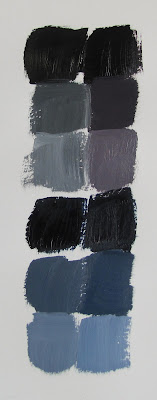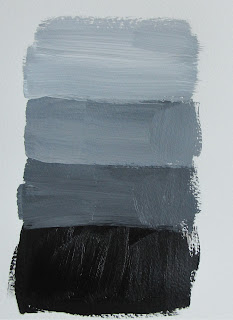The Magic of
Values in the Acrylic Landscape
Class #1
by Karen Ilari
Join me in this step by step class - learn to see and match values.
First let's talk about values, what they are and how they help make better paintings...
There is a lot to think about when you are painting. And a lot to learn! Let's start with this - there are four main concepts to master in painting:
- Values
- Drawing
- Edges
- Color
The first and most important, especially for landscape
painting, is VALUE
It is also the area that most painters struggle with,
especially at the beginning.
What is Value? Simply how light or dark something is.
To illustrate, we use a Value Scale. This is a gradation of
9 values from Black to White
You can hold it up against your work and your reference to
compare.
The challenge is to train your eye to see value, whether in
a reference photo or in real life. Our natural tendency is to see color and
form over value. We will notice first that something is red, or blue and paint
it that way. Or that is an object we recognize, and what shape it is. You have to learn to stop and REALLY SEE WHAT IS THERE! In reality red in light and shadow are very different in value and
color. In fact black in light can be lighter than pink or yellow in shadow. Sometimes an object and its background will be the same value! Creating lost edges - where you can't see where one thing stops and the next starts.
As an example, let's take a look at this painting of mine
"In the Morning Light" :
You can see that his dark grey T shirt in sunlight is a
lighter value than the light brown and
white of the sign in shadow, or the white lettering on the awning in shadow.
So we have to learn to see the values first, before color,
and then to match them.
EXERCISE #1
Supplies: Mars Black and Titanium White Heavy Body Acrylic Paint.
watercolor paper
flat synthetic brush - about 1/2" wide
water container, paper towels, palette
Copy the value scale above and print it out. Preferable on photo paper.
Now match these values and paint your own 9 value scale! Easy! You might be surprised!
This gives you practice in focusing on seeing and matching a value. And if you are new to acrylics, some time to get used to how they feel. Don't use any mediums, just paint and water. Keep the paint thick and try to create thoroughly mixed squares of even value. You can punch a small hole through the middle of each value on your printed scale. This way you can hold it right on top of your work to isolate the value and see if you have a match.
And remember - ACRYLICS DRY DARKER! So don't be surprised if your perfect wet value is too dark when it dries! This is just something you learn to compensate for in painting with acrylics, so this exercise is good practice for that too!
Okay, Now that you have done that....
What do Values do for us?
- Distance - as things recede into the distance, they
get lighter. They also lose some of the contrast. In other words - the
lights get darker, the darks get lighter. The value range is higher on the
value scale and closer together.
Here is another of my paintings to illustrate - "Summer
Pond"
Take a look at the trees - compare the value on the sunlit side and
shadow side of the tree in the foreground and those in the middle and
background. Do you see how the lights get darker and the darks lighter progressively
as you move back in space? This - along with size, color and detail, creates
the illusion of distance.
- Light - the contrast from
sunlight to shade. A sunny day will have strong value contrasts. An
overcast day will have values that are darker and with less contrast -
closer on the value scale. In fact you can "push" the values -
make the lights lighter and the darks darker - in your reference to create
a more sunny day! Magic!
- Form - In a dark room you can't see form at all.
It is the light as it strikes the surfaces of an object that describe its
shape to us. On the other extreme a very bright light setting, with light
hitting all the surfaces, will wash out an object so we can't see its form.
Correct placement of values on an object are key to it looking real.
- Composition - The patterns
formed by light and dark in a painting are key not only to realism, but to
its visual impact. We draw the eye and lead it around our painting by
using contrast. Reducing your image to a simple design of 3 or 5 values
will reveal its essence. The abstract pattern that is at the core. Once
reduced in this way you can manipulate the forms to best tell your story.
So - now let's do a little painting - and practice seeing and matching values some more:
Exercise #2
Supplies: Same as exercise #1, but this time use a 9" x 12" stretched canvas or canvas panel.
Step One: Choose
a photo
We start with a simple reference photo like this one. I chose this for it's simple large shapes, forms progressing into the distance and the obvious effects of light and shadow.
I've already cropped it to the size and placement I wanted - 12" wide by 9" tall.
I've even added some to the left hand side in photoshop because I wanted my
tree to be about a third of the way from the side. These are compositional
ideas that we will talk more about in another lesson. I used the "Rule of Thirds" which means dividing your canvas into a tic-tac-toe and then putting main elements on the intersections of the lines, and main divisions - like the horizon or edge of the field on the thirds.
Step Two: Change
your photo to Black and White:
You can use any photo program to change your color photo
reference to a black and white version. I use Photo Shop Elements. Then choose
Enhance -> Adjust Color -> Remove Color.
Step Three: Paint
your image with only 5 Values
The key tool for seeing values is
to squint your eyes - or blur them - soften your focus.
The idea is to make a decision in
each area as to which of your five values its closest to and then simplify the
forms, removing the detail. Keep your forms simple - big geometric shapes with no detail at all. Mix your color on your palette so you get a nice even tone. Clearly defining the value of each shape. You will end up with something like this:
It looks simple but it isn't!
Don't be discouraged if this takes you a long time! I find I have to keep
stepping back and reminding myself to look at the LARGE shapes, not the
details! Though there are lighter and darker areas in each shape, you want to
look for the overall value you see when you squint your eyes. Remember - NO DETAIL - LARGE SHAPES - SOLID EVEN TONES
But that doesn't look real! You're
right! We are starting at the most basic building blocks. The foundation for
our painting. We are using our creativity to tell the story from our own unique
perspective. Once you have blocked in what you see, Ask yourself some
questions...
How Can I
Improve this Image?
Are there areas that are confusing in the photo? Not enough value shift
to really see the distance? CHANGE THEM! At this point you can clearly see
those shapes. are they working? Use your artistic license and tell
your own story.
Do the forms
create an interesting, appealing pattern?
- Avoid
half dark, half light. Thirds are always nice. I've chosen about 1/3 dark,
with the rest medium or light
- Is the
focal point shape clear and placed in the best spot? The large tree is our focal point.
- Use
big shapes, connect your shapes, avoid polka dots - isolated spots
- Look
at the form shapes - are they appealing? I changed my tree shape so it
wasn't quite so square, and had branches come down to connect with the
shadow.
Are you Leading the
Eye?
- Provide
an entrance into your painting. Here I've altered and emphasized the area
of light wildflowers in the photo to use it as a path for the viewer to
follow into the painting.
- Define
your focal point. The area with the highest contrast will draw the eye
first. I have chosen the tree as my focal point and am using the light
value and form of the fallen log, the light value of the flowers, the
spots of sky peaking through and darkening the value of the tree itself to
really define it as the center of interest. It is the area with the
darkest darks and lightest lights
- Create
movement and rhythm. Once you have led the eye in and to your focal point,
be aware of the lines that the eye will follow next. Don't have lines that
lead them directly out of your painting. In mine the eye will go from the
tree to the mid ground trees whose shape leads the eye up and around in
circular motions that bring it back to the foreground.
- Leading
Lines. The large shapes in your painting will create lines. Be sure they
are supporting your focal point, and not leading the eye out of the
picture.
Here you can see the lines that invite the viewer in and to
the focal point, then around and back in. Without the forms of the mid ground
trees "stopping" the eye, it would just travel right out of your painting.
You want to keep your viewer engaged and directed back into your painting.
You can also see how all the other lines formed by the
shapes lead to the focal point.
WOW! That's a lot
to think about for this simple little design!
Yes! It is!
But remember, this is your foundation! There is a lot of
design and planning that goes into this stage. Each step builds on the next. If
your foundation is strong, your painting will be strong. It will catch the
viewer's eye from across the room and draw them right in.
Remember, as you train your eye and hand, this stage will
take less and less time. In time you will not need to physically go through
this step, but will visualize it in your mind before you start.
And you will be soooo happy when this concept falls into
place. Your paintings will take a huge leap!
Exercise # 3
Find some images to practice
with. Magazines, online, any will do. Look for the elements described above. Distance, Simple shapes, clear light and shadow.
Use your 5 values of paint on
some watercolor paper
Paint a bunch of small 5
value studies of these images. Just 3" x 4" or so.
Remember:
No detail
Large shapes
Define the focal
point
Show the distance
Create appealing
design














